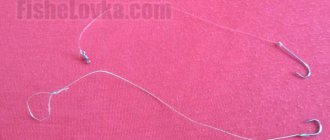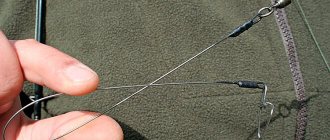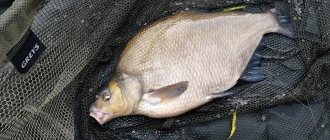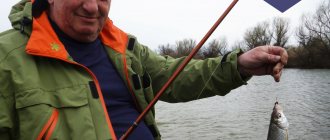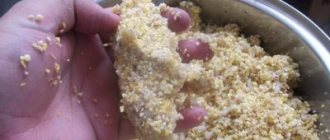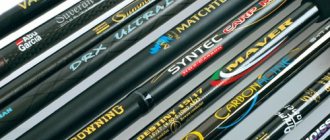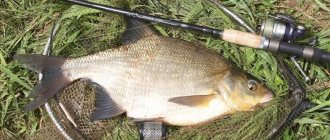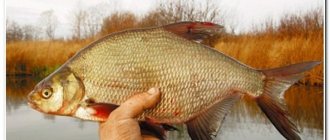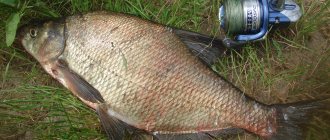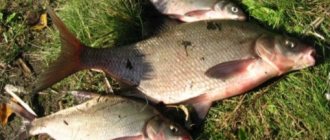The correct leashes for the feeder with hooks are the last link in the equipment that is in direct contact with the fish. A lot depends on the installation. If this element of the feeder tackle is done incorrectly, then you may simply not get a bite. At the same time, the feeder leash is not just a thinner outlet for the hook, as in the donk. This is a consumable item that you need to actively experiment with when fishing. Selection of working equipment is part of the feeder tactics. In this article we will look at how to knit leashes for the feeder, which ties to use depending on the fishing conditions.
Leash in feeder installation
On donkeys, we are used to the fact that the leash is placed in a rig and used until it is damaged. In the feeder, a different approach is needed. It is better for the fisherman to have with him many different elements of equipment connected in advance. Especially for fishing in an unfamiliar body of water. Frequently replacing hooks on feeder gear while fishing is normal practice. This, together with the feeding system, point casting, correct installations, is what makes the feeder so catchy. Different leashes are used, depending on the conditions of the reservoir, the type of fish and the installation used.
Asymmetrical loop
Working with leashes during fishing
The length of the leash for the feeder, the diameter, size and configuration of the hook largely depend on both the objective realities of fishing and the personal habits of the reservoir. If an angler successfully catches fish using some kind of equipment that is not recommended by top athletes, it means he is doing everything right.
You won’t find any kind of information on the Internet, and it’s often contradictory. Some recommend using ultra-thin diameters, up to 0.08 mm, while others argue that there is no need to thin the feeder. For an amateur fisherman, it is important not to blindly copy someone’s opinion from a YouTube video, but to use your head. Due to the abundance of recommendations, you may get the impression that in feeder fishing you need to master a lot of science and stock up on a carload of equipment. However, everything is simpler - we use ordinary leashes from a standard fishing line, 30-40 cm long. For roach and small whitefish - 0.12, 0.14 mm, for crucian carp - up to 0.16 mm, for bream with carp - up to 0.25 mm.
For passive biting in pressed-in reservoirs, we take 0.1 mm - with feeder gear, even with such a web it is possible to catch bream up to 2 kg in weight. Despite the recommendations coming from all sides to always use thin lines, if the fish are caught normally and there are a lot of them, it is better not to thin them. This will only add hemorrhoids to the angler. To begin with, it’s better not to bother, but to use a fishing line of 0.14-0.16 mm and a length of half a meter (plus or minus 20 cm, we already adjust this when fishing, depending on the characteristics of the bite).
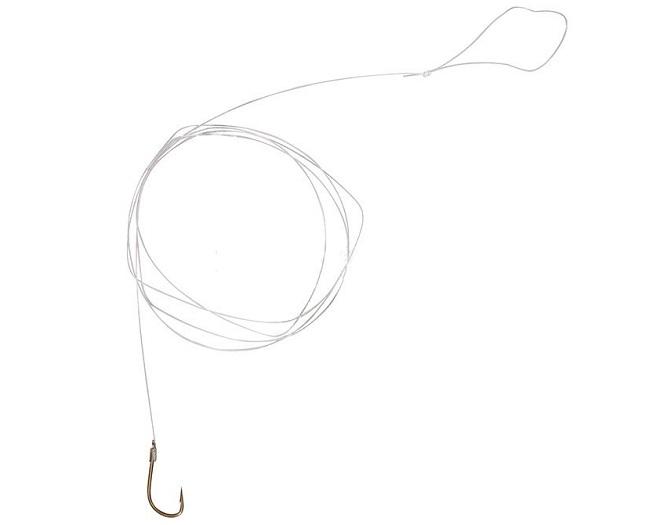
Anglers who have already gained experience can even bother with leashes. This is a large layer of possibilities and equipment options. In moments of bad bite, a subtle understanding of which leash and hook to put, longer or shorter, thicker or thinner, can save your fishing. Naturally - along with the correct general feeder fishing tactics, choice of location and equipment. The general approach depends on the installation features:
- Classic feeder - from 20 cm to 1.5 meters long, both thin and thick enough for catching large fish.
- Flat method - short leashes. This is due to the peculiarities of installation and fishing.
- Fishing in the water column with falling bait. Installation - helicopter and two units. Thin leashes, up to 2.5 meters (with a long rod), with small, light hooks, preferably made of floating fishing line.
On the one hand, the length and diameter determine the fishing conditions and the activity of the fish, on the other hand, the feeder installations used. Read more about installing a feeder rod. Let's look at what leashes need to be placed in different directions of the feeder tackle and why they are the way they are.
Classic feeder
In standard fishing with paternoster rigs, asymmetrical and symmetrical loops, running or helicopter, the optimal length of the feeder leash is 70 centimeters. Of course, this is not a rule. Some anglers like to fish everywhere with short leashes. However, some fishing practice has already developed. Longer ones actually catch better, especially on rivers with current. Cautious fish are sometimes afraid to come close to the feeder, especially on a clear bottom. During the current, the fish can stand on the feed stream below the point where the feeder is located, and a short leash simply will not reach its area of interest.
Length
The length of the feeder leash in still water needs to be shorter (in general), 30-50 cm. The hook with bait still falls vertically approximately at the landing point of the feeder - there is no current. The exception is when catching cautious bream, when you need to use the pulling method. That is, after the feeder falls, we pull it towards us at a distance of 70-100 cm in order to remove it from the feeding spot and not scare the fish. Accordingly, the length of the leash is the same 70-100 cm, so that the hook with bait ends up in the stern area after pulling. Naturally, this method does not work on a current, where the force of the water flow already pulls the hook away from the feeder. An article about feeder fishing for bream.
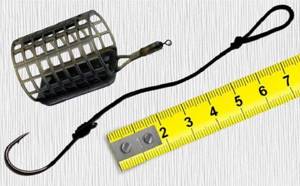
To catch roach, chub, ide and other fish that like to grab bait when it falls, longer leashes are needed. Sometimes even bream doesn’t take it from the bottom, preferring sinking bait. In this case, especially in currents, long tails, up to 1.5 meters, work well.
The tactical characteristic is precisely the length. The length is also selected during fishing. The bites are very weak or absent altogether - make it longer. On the contrary, if the fish bites greedily and swallows the hook deeply, we shorten it. The length is selected along with the choice of the moment of hooking, until successful fishing is on stream and occurs after each bite. You shouldn't bother with millimeters and centimeters. But when lengthening or shortening, you still need to work in constant increments, for example, 7 or 10 centimeters.

Diameter
The diameter of the fishing line for the feeder leash can be taken much thinner than when fishing with a bottom. Feeder is a more advanced tackle. The flexibility of the blank and the drag on the reel allow you to catch fairly large fish on thin lines. Read more about feeder gear. For hobbyists, the standard diameter is 0.12, 0.14 and 0.16 mm. The water is clearer and the bite is careful - we put thin ones, in muddy water for active fish - thick ones. For trophy bream, large crucian carp or carp, we use fishing lines with diameters of 0.18-0.25 mm.
Which leashes to use for the feeder will be determined by the fishing conditions and the fish the angler is targeting. In addition to experimenting with the leash, you may need to change the entire installation. The feeder is universal. You can choose a working version of feeder equipment for a variety of conditions. Many fishermen are puzzled by how to make a feeder tackle so that the leashes do not twist. But this problem is not from the field of “drive engineering”, but relates to installations. In a proper feeder installation, a twist or bend (or a fastening point, as in a helicopter rig) is specially made so that the leash does not get caught or twisted. Details about each installation can be found in the articles on our website in the “Feeder/Equipment” section.
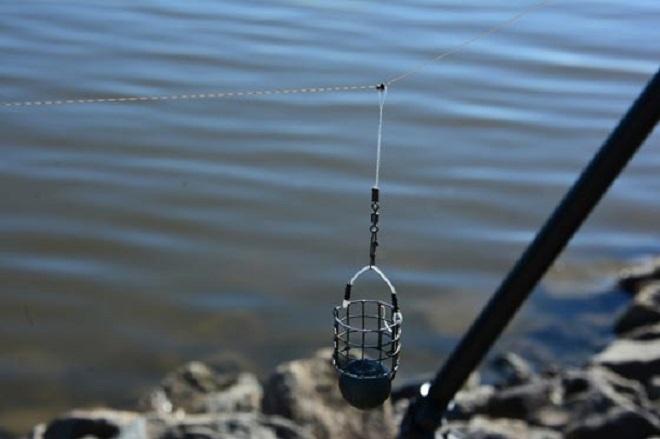
The diameter depends on the overall structure of the tackle and the size of the fish. Soft rods with monofilament and a long reel drag can help you catch large fish with the thinnest fishing lines. If the rod has a fast action, oak, and even on a cord, we take more powerful leashes. But even here there is a way out - you can include an insert made of feedergam into a rigid equipment from the point of view of shock absorption. This will allow you to use 0.1 mm fishing line even if the base is non-stretchable braid.
Short leashes
In feeder fishing for crucian carp, tench and carp using classic rigs in still water, shorter leashes are needed. This fish loves to dig into the feeder itself and suck out food particles from it. In such fishing, on the contrary, there is no need to move the hook away from the feeding device - the bait should lie nearby. Secondly, on a long leash in still water it is difficult to see a careful bite. It will sink to the bottom in the area of the feeder, but its line will not stretch out from the hook before installation, but will lie wavy or in loops. That is, the bite will become visible only when the fish has already taken the bait and pulled the equipment into a line. This is not a problem with active biting. However, a cautious fish may throw out the hook before the angler detects a bite using the quiver tip. Therefore, in such conditions we set leashes of 20-30 centimeters. Read more about catching crucian carp with a feeder.
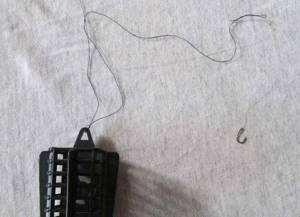
In general, a properly selected leash combines the following points:
- The fish eats the bait, the bite is visible and there is no movement when hooking.
- There are no breaks when fishing, but there is definitely no lack of bites due to the excess diameter.
In feeder fishing, you must always be prepared for the approach of large fish. This is the ultimate goal of fishing. When fishing on a river, small whitefish usually bite first, and only then does a large fish approach the fattened point. Therefore, if there is a high probability of a large fish biting, it is better not to thin in order to catch a couple of extra roaches. We are not at competitions where every gram of catch is important. It is more important for an amateur not to miss that long-awaited trophy, in anticipation of which the point is fed.

Leash holder
To ensure that fishing leashes are always at hand, do not get tangled, and can be easily changed, you need to use a leash holder. Often such an accessory can be seen on the fishing trips of famous athletes - a massive leash holder in which leashes are laid out along lengths measured with high precision. With the help of some of them you can not only store, but also knit leashes. In it they are stored in their natural form, elongated in length, without kinks. You can even store one and a half meter leashes! In cases where it is not possible to purchase and use one, use smaller ones. They have no less functionality, but in them the leashes are stored bent two or three times. To make the behavior of the leash more natural, after it has been removed from the leash and secured, it must be pulled a little to straighten the bends.
There are often recommendations to make a leader from a piece of pipe insulation. It is a foam pipe into which pins are stuck. In this case, the leash clings in a loop to a pin, and then wraps around the insulation, at the end a hook is stuck into it. This leash has a trick. It is compact and inexpensive. However, when the leash is stored on it for a long time, especially in the heat, in the trunk of a car or near the engine, it takes on an extremely unsightly appearance.
The fishing line begins to deform, and due to the porous structure of the material, this happens very unevenly. Different deformations occur in different parts of the fishing line; moreover, when winding, it puts very uneven pressure on the porous material. According to the author, it is better not to use a leash at all than to use this device.
The option without a leash at all also exists. The author of the article fishes with a feeder and ties leashes directly while fishing. You just need to take a looper and hooks, and you can measure the exact length using the divisions marked on the first bend of the feeder. The hook is inserted into the hookkeeper, then the leading line is pulled along the scale, and a loop is knitted at the required distance. Everything is very simple and convenient. Although, of course, this will take more time than installing a ready-made leash from a leash, but the leash line is less damaged.
Victoria Leshchenko
I've been working hard in the fishing tackle department for the past six years. I can help you assemble almost any gear.
Ask a Question
A good quality leash is the key to successful fishing! At the same time, however, you need another accessory - a hook holder, in which the hooks are inserted according to type, are clearly visible, and are convenient to take. When choosing leader length, yours truly starts with a longer leader, then gradually cuts the hook and reties until you get a good execution and number of bites.
I would like to say a few words about the environment. All cuttings of fishing line, including the leader line, must be placed in a garbage bag. Any feeder should have it on hand to put bait bags and other garbage there. Be respectful of nature and do not throw garbage on the shore.
Flat
The length of the leash for the feeder in flat and method rigs is no more than 15 cm. Naturally, such a short length will not absorb properly. Therefore, thick, strong fishing lines or leader materials are used (for carp). The thickness of the feeder leash on flat fishing line is 0.25-0.3 mm. The design is the same - there is a loop on one side and a hook on the other. The leash is attached to the main line through a noose swivel. Some models of flat feeders are equipped with a special connector for a feeder leash. More details – equipment for flat feeder.

No bites are visible, the fish swallows the hook deeply
With the correct leash length, the fish should be caught by the lip. If the leash is too long, the fish swallows the bait with the hook, or spits it out without taking out the entire leash and, accordingly, without showing itself in any way. In such cases, when the hook is swallowed deeply or the bait is knocked down by the fish without the rod tip reacting, the length is reduced. You should shorten the leash gradually - 5–7 cm at a time, since shortening the leash too much can lead to worse bite and frequent “empty” bites.
Read more
How to fish with a feeder on a river with current
Fishing with falling bait
Mounting a helicopter and two units is most suitable for such fishing, since the design does not have a thick bend or twist. And without them, the leash sinks to the bottom more slowly. Fluorocarbon is not suitable for this kind of fishing, as it is heavy and sinks quickly. The angler’s goal is to achieve the longest time for the bait to sink to the bottom. To do this, you need a long and thin leash - up to 2.5 meters, diameter - 0.12-0.1 mm (for trout, large ide and chub - 0.16-0.3 mm). It is realistic to achieve an immersion time of about a minute. During this time, the fish scurrying above the bottom manages to find the bait. This method is sometimes unrivaled when fishing for roach, ide, chub, trout and spring bream. Read more about fishing with a feeder in thick water in the article on installing a helicopter for a feeder.
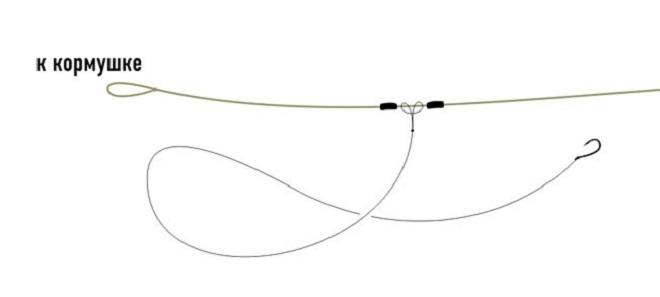
The principle of attaching a leash in a helicopter installation
Feeder leashes
Most anglers knit leashes for the feeder with their own hands. Stores also sell ready-made bundles - for example, leashes for the Owner feeder. But this is not economical, rather for athletes. Nothing prevents an amateur from preparing various diameters and lengths in advance. At first, you don’t have to do this at all, but knit right away on the pond. It's a matter of convenience. It is more important to pay attention to the quality of the fishing line and hooks. Lead line and hooks in the feeder are something you cannot skimp on.
fishing line
For leashes on the feeder, the fishing line chosen is of high quality and strong. Here it is better to trust well-known manufacturers. Firstly, the diameters correspond to the declared ones, and the breaking load is normal. Both a special leader line for the feeder (indicated on the box) and a regular good monofilament will do. We will not give ratings of manufacturers here - there are hundreds of them. And good brands are already well known - it’s worth reading fishing forums. The leader line for the feeder is a soft monofilament without memory, with appropriate breaking loads and diameter. For short carp leashes, a stiff fishing line is better - when it falls to the bottom, it will slightly move the hook away from the feeder.
Which fishing line to choose and use for feeder leashes from the point of view of a specific brand is a personal matter for each angler. Each fisherman has his own options, which he considers the best. Sometimes you have to try several.
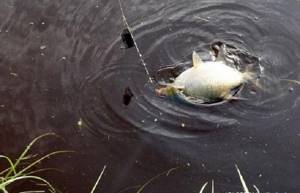
In the flat method, you can use both monofilament and lead feeder material, carp. Sometimes regular braid is used. However, a braided leash for a feeder easily gets tangled - if you use a cord, then use a special carp leash material.
Fluorocarbon feeder leads are needed if fishing is on shells or sharp stones - other materials will simply be cut off. And fluorocarbon, due to its rigidity and abrasion resistance, adequately withstands such tests. On a shell, fluor frays when damaged, but does not break immediately, like monofilament. This outlet simply changes in case of damage. And braid and regular monofilament are cut immediately in such conditions - even without a fish on the hook. There is no need to be fancy with the colors of the fishing line - regular transparent is best.
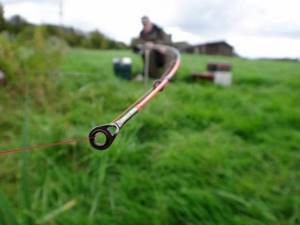
Fastening to installation
In classic feeder installations, the lead to the leash ends with a loop. In flat – with a swivel. Therefore, the most appropriate method of fastening is a loop-to-loop noose. Therefore, all feeder leads are made with a loop at the end. This is a universal option - you can attach almost anything to anything with a loop on the noose. Plus this method is simple and fast. The leash for the feeder is knitted in a minute. At one end we form a loop with a regular figure eight or a surgical (double or triple) knot, and at the other we tie a hook. The length of the feeder leash is selected based on fishing tactics.

The leash on the feeder tackle can also be attached using special quick releases or connectors. It's fast and convenient. However, some feeders with experience argue that you should not add additional elements to the design, you should strive to make everything simpler and more reliable. In this sense, fastening with a noose in a loop is beyond competition.
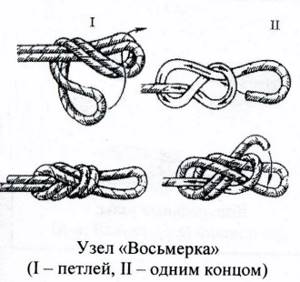
Eight
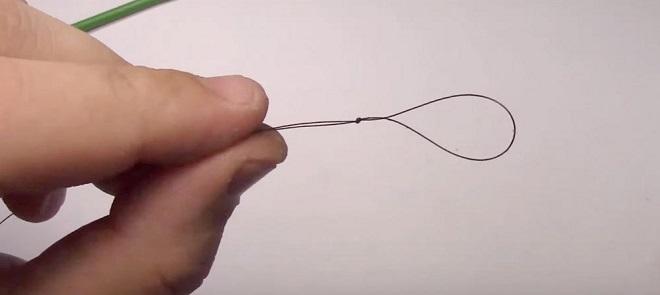
You can tie the feeder leashes in advance for a specific fishing purpose, or you can make a large set altogether - this is for everyone, depending on who you like. The presence of a large number of pre-prepared equipment facilitates the tactical work of selecting the optimal option on the reservoir. You can quickly try many options, and you don’t need to knit anything. This is especially true for anglers with thick fingers and blurred vision. It’s easier to prepare everything at home in advance than to swear and tie small hooks on a thin line in the wind and in poor visibility.
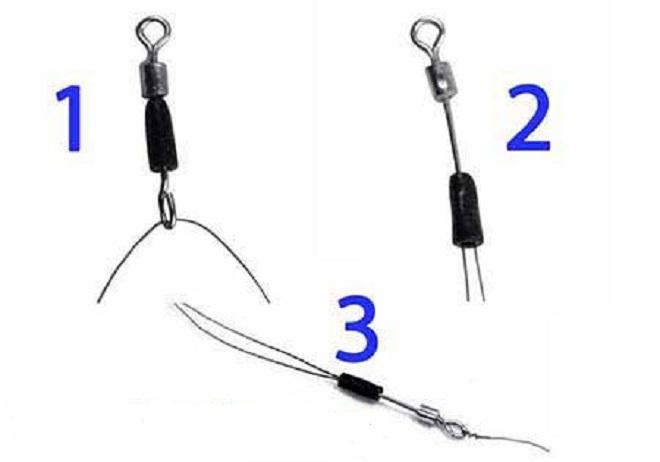
Via quick release
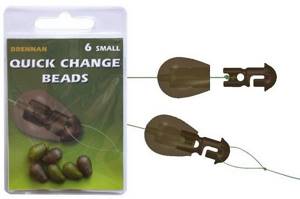
Connector
Choosing the right fishing line
When choosing a material for tying leashes, you should pay attention to the properties and characteristics of the fishing line used for this. Different feeder fishing conditions require different element parameters. This is precisely what determines the variations in changes in fishing criteria, which can differ significantly from each other, thereby providing the opportunity to obtain positive fishing results in different situations. Leading materials are characterized by the following properties: rigidity, colors and shades of the material, the magnitude of the breaking load and the diameters of the thread used for the element.
By diameter and breaking load
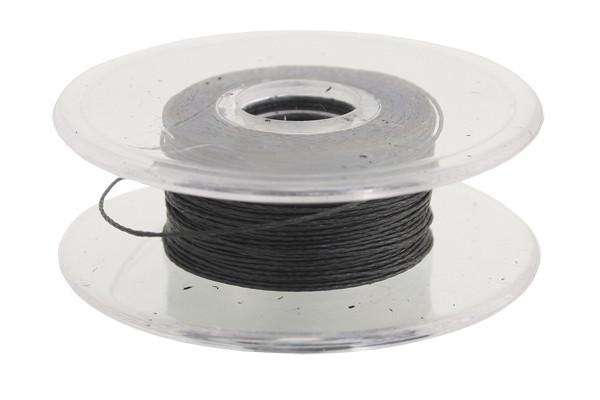
The diameter and breaking load of the driving element are selected based on the trophy planned to be caught, or more precisely its mass. The leash on the feeder must ensure the reliability of landing the caught fish. The angler will be able to find out the diameter and magnitude of the breaking load when purchasing the leader material, where these parameters are indicated by the manufacturer on the packaging. It is natural that the larger the diameter of the thread, the higher the breaking loads. When selecting the diameter and breaking load of the material, the excess forces that arise when fighting caught fish are taken into account. The weight of the trophy alone does not guarantee the correct selection.
Important! The weight expected in the catch is increased by at least 25% to eliminate breakage from the resistance forces of the fish, and even in the best case they double the weight and, based on these data, select the diameter and breaking load of the fishing line.
The rest of the overload is distributed between the correctly configured clutch of the tackle, the rod blank and sometimes used to absorb the jerks of the trophy, feeders and shock leaders.
Rigidity
The rigidity of the material affects the sensitivity of the equipment and the spatial location of the bait in the water column or at the bottom of the reservoir. Rigid fishing lines are more difficult to tie into a piece of equipment, and it greatly affects the thinness of the equipment, making the installation rougher. But at the same time, this quality helps to achieve the delivery of the bait and its subsequent retention in the water horizon in a more stable state than a soft thread. Lines with low rigidity, on the contrary, make the rigs sensitive, which is suitable for catching more cautious fish, but such rigs are more likely to get tangled and, at longer lengths, are more difficult to control when casting and reeling in.
Color

The color design of the cord is used to disguise the equipment. The camouflage shade of the thread is selected based on the color of the water and the color of the soil. Transparent fishing lines do not always satisfy fishing conditions, because they become clearly visible against the dark background of the bottom or in water blooming with algae, creating glare and reflecting light. Therefore, light green, yellow and green threads are used for green water, black is most suitable for muddy soils, red and brown fishing lines are invisible on clay and sandy bases, and in clear and clean water blue and colorless leader materials camouflage the equipment well.
Fidergam
Feeder rubber allows the use of thin leashes even on heavy river-class gear equipped with braid. The cord does not absorb shock, and therefore, when fishing, you can lose large fish. Of course, you can put a thicker line. What to do if it doesn’t suit fat people? In such cases, the feeders help out. A spacer made of this material is inserted between the leash and the feeder mounting. Equipment options depend on the installation - there are several of them. More details - insert from feedergam.
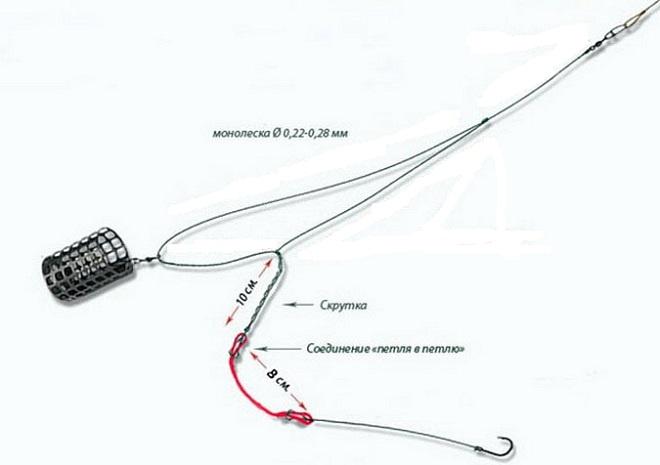
For current and still water
As mentioned earlier, the leash for current should be shorter than for still water. This is due to the fact that when it falls, it will stretch along the current, and not fall down after the feeder, and a long leash will place the bait far from the bait. You should also use a thinner leader line. The fact is that in still water the fish takes the bait much more carefully, because it does not have to waste energy on keeping the body in the current, and the bait will not go anywhere, there is time to figure it out. For example, if you can actually fish in a current with leaders of 0.12 mm for any conditions, then for weak currents and standing water 0.1 and even 0.08 mm are used. Thin fishing line gives especially good results on pressed-in reservoirs, urban and suburban ponds and pay zones.
Hooks
An important point in feeder equipment is the quality of the hooks. Fishing sometimes occurs at long distances, 80 meters or more. Therefore, it is important that the hook cuts the fish at the slightest stretch, immediately. Typically, a classic feeder uses small hooks No. 16-10 of the international classification. Smaller or larger ones are already special moments for rare cases - purposeful catching of bleak or vice versa, catfish or trophy carp. The size of the hook is not selected according to the fish, as some people mistakenly believe, but according to the size of the bait.
For bloodworms and maggots - smaller, for worms and corn - larger. Regular hook shapes with straight hooks will work. The hook size is also selected depending on the activity of the fish. With active biting - larger baits and, accordingly, hooks, and vice versa. For the flat method, for ide, chub and carp, large crucian carp, you need round hooks with a short shank made of thick wire. For roach, use slowly sinking bait - small and thin. Read more about feeder hooks.
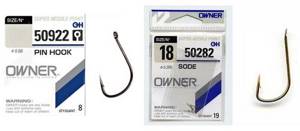
Preparation and storage
The process of knitting leashes for a feeder is not complicated - a figure eight loop and a hook at the end. It is more important to choose the correct fishing line diameter and length. This can be done manually, or using loopers or knotters. If you need to prepare a large quantity, it is convenient to use a special crochet crocheting machine.
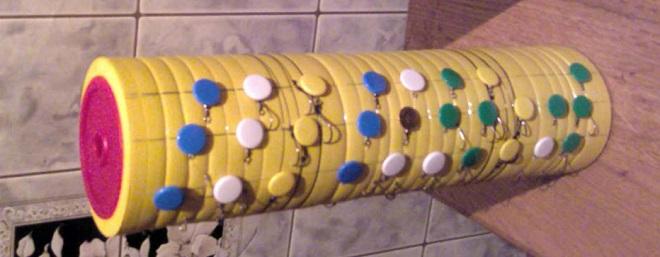
It is convenient to store tied feeder leashes in special leash holders. You can use store-bought options. However, it is easier and cheaper to make a leash with your own hands in the form of a cylinder of foam (polyurethane). The hooks are stuck directly into the foam, the fishing line is wrapped around, and the loops are secured with stationery needles. Read more about leashes.
About quick releases:
Subscribe to the channel:
YouTube channel RYBAFAN
We are VKontakte
How to knit leashes for a feeder with your own hands
Learning to knit a leash for a feeder is quite simple, having mastered the technique of tying knots to connect the fishing line to the hook and form a loop.
Important! To knit loops, it will be useful for the feeder to have and learn how to use such a device as a looper, which greatly simplifies the work and saves time, ensuring the reliability of knitting.
To make feeder leads from tools, you will need scissors or a sharpened pocket knife. The required piece of material is measured from a skein of fishing line, adding about 20% of the length to it to form a loop and make it easier to make a knot for connecting to the hook. Using a figure eight knot, a loop is created at one end of the cut. The other end is connected to the hook with any knot that the fisherman can tie correctly and reliably. Before tightening the knots, in order to avoid defects caused by overheating of the material, the screeds are moistened with water or saliva. After forming the loop and attaching the hook, the excess ends of the fishing line are cut off, leaving pieces of no more than 2–3 mm.
Leashes of various lengths, tied in advance, with different types and sizes of hooks and from materials that differ from each other are stored in a special device called a leash.
